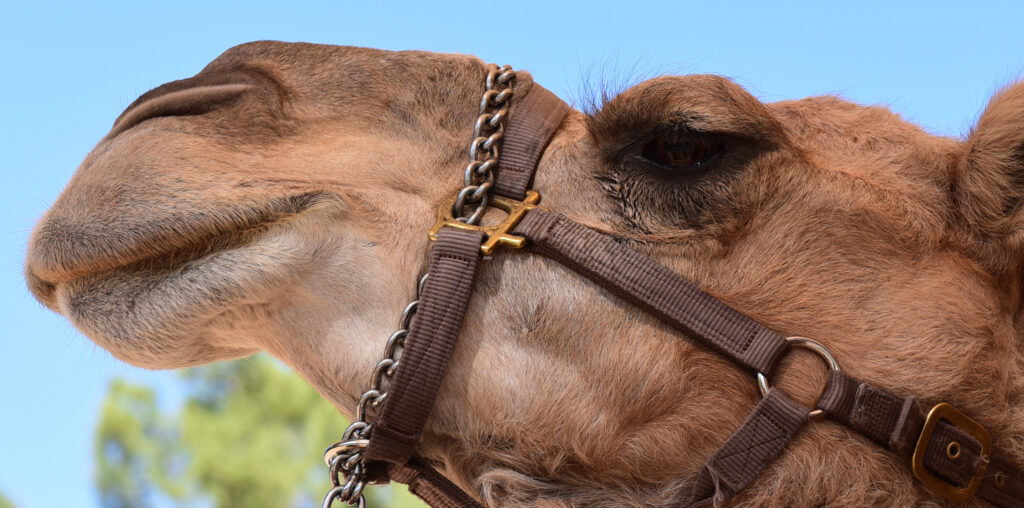
Word spread through the territory – a beast roamed the Arizona frontier, though each sighting was little more than a glimpse: A flash of red. Hooves and old bones. When the beast trampled a ranch woman to death at Eagle Creek, a witness described the creature: Red, tall, and ridden by a devil. It was 1883, and there were grizzly bears, wolves and jaguars in Arizona then, but this thing was different.
Then a man named Cyrus Hamblin saw the creature and said it was a camel. He should have stopped there, but he didn’t. He said the camel had a dead man strapped to its back.
Later, some miners spotted the beast and fired their rifles. The camel fled, and something tumbled and fell to the ground. The men ran to the spot and found a human head, with snarly hair. Other stories followed, feral, whiskey-throated fables that stacked like tumbleweeds. The beast killed and ate a grizzly bear. The beast jumped across the Black River, from canyon rim to canyon rim, in a single bound.
Yes, Arizona had camels once
The only fact we can hang this story on is that the U.S. Army imported camels to move supplies across the desert. The passage from Santa Fe to California was long and treacherous before the first railroads were built, and so the idea was passed around for a while, but nothing came of it until Jefferson Davis became secretary of war. Camels could endure the heat, carry enormous loads, and travel long distances without water.
Davis sent three men abroad with $30,000 and orders to buy camels – Lieutenant David D. Porter, Major Henry C. Wayne, and Gwinn H. Heap, a diplomat. They had only a vague idea about where to find camels – somewhere in the Middle East.
The British Army had purchased 8,000 camels for the Crimean War, and there was a camel embargo in Egypt. A viceroy gave them six street camels as a gift, probably to get rid of these American visitors, Forrest Bryant Johnson writes in The Last Camel Charge. The United States was only 80 years old, but it was proud, and the men had done their homework.
“The camels your government sent to us are worthless and diseased,” Porter wrote.
The Egyptians backpedaled, said it was all a mistake, and gave Porter six healthy camels. In time, the Americans returned the United States with more than two dozen healthy camels, and several camel handlers, including a man named Hadji Ali, renamed Hi Jolly. They retrofitted the ship to handle the swaying beasts, each with its own harness.
When the ship would pitch, “it looks as if they would all roll higglety pigglety in a helpless mass to leeward. It is an amusing sight to watch their long necks swaying backwards and forwards altogether in a line,” Heap wrote. His papers, on file at the Arizona Historical Society in Tucson, also report that the camels would also shriek and squeal and “spit out a mass of masticated hay which is neither savory nor clean. One of them covered me yesterday with a shower of this stuff because I was endeavoring to make him lie down.”
You can’t have too many camels
After they unloaded the camels at Indianola, Texas, Porter set sail to purchase more.
Major Wayne stayed behind to work with the first load of camels. The locals laughed and pointed at these funny animals, all legs and necks and humps, so Wayne led a camel into the crowd and ordered it to kneel. He loaded the beast with two bales of hay, more than 300 pounds apiece, then added two more bales, until it had more than 1,200 pounds, then ordered the camel to rise, which it did, slowly but without straining. The crowd cheered. Wayne had made his point. The men ultimately purchased 75 of the beasts, according to a report of the Secretary of War published in 1857.
But the camels, with their funny smell and their high profile, could spook horses, and spooked horses could be dangerous. A number of soldiers remained skeptical, and American troops never embraced camels. When the Civil War began and the west was more or less abandoned, when railroads linked the coasts and the desert became easier to cross, the camels were no longer necessary, and eventually their handlers turned them loose. Davis became president of the Confederacy.
Arizona history is tangled in folklore, yarns and lies. The difference between the history and folklore is the source of information. History relies on archival documents, government reports and other primary sources – diaries, letters and old photos, and this is why history books are largely judged on their source material. Folklore feeds on stories that are handed down, without verification, from one person to the next, or one carelessly written history book to the another. The frontier press is useful, but only up to a point, because territorial reporters were not known for their skepticism.
Folklore, not history
The story of the red ghost appears in a newspaper story that cites a coroner’s report on the woman’s death, and the testimony of a witness, which in a perfect world would be on record. The state archive does have coroner’s inquests from Apache County, beginning in 1882. But the report from 1883 is missing. This story might have more meat on the bone, but this is Arizona, where history has died a thousand deaths at the hands of document thieves. And so we are left with a bit of folklore, perfect for a work of fiction, such Tea Obreht’s Inland, perfect for the internet, where facts are optional, perfect for newspapers of the day, which needed to fill space. I like this story, but I can’t say that I believe it; I need a document. I need a witness, something more than a frontier journalist spinning a tale.